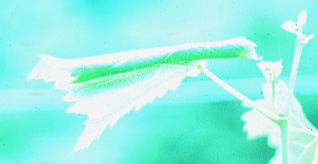
Grape leaffolder, Desmia funeralis (Hubner)
This is taken primarily from an
extension bulletin by D. G. Pfeiffer & P. B. Schultz, entitled
"Major Insect and
Mite Pests of Grape in Virginia" (Va. Coop. Ext. Serv. 444-567 (1986))
Pupae of this moth overwinter in folded, fallen
leaves. Adults are dark brown with
white spots on the wings. Both sexes have two white spots on the
forewings; on
the hind wings, males have one irregularly shaped white spot and
females have
two white spots. Moths appear in late May or June. Females oviposit on
canes
and leaves, especially in the angle of the leaf vein and surface. After
hatching, larvae begin feeding on and folding the leaves; leaves are
rolled
in thin-leaved varieties. Caterpillars are light green with dark
markings near their heads and reach lengths of 2 cm. Feeding
continues for about a month and the ensuing pupal stage lasts about ten
days. A second generation is present in August and September. The
second
generation is more damaging. Each larva will make two or more rolls
during
its development. Infestations are often localized within a vineyard and
usually occur first along borders. Grape leaffolder has been commonly
seen in some Virginia vineyards.
Back to Virginia
Vineyard
page
Back to Virginia Fruit Page